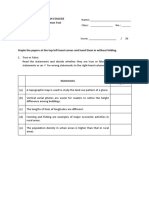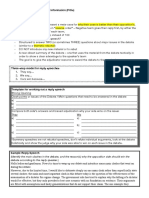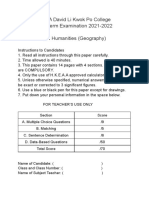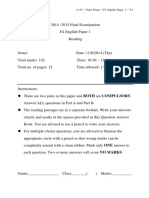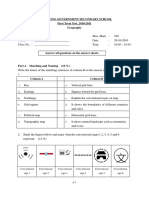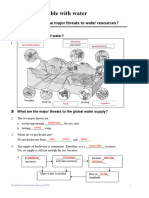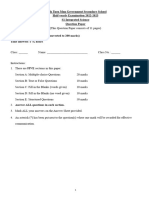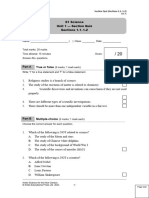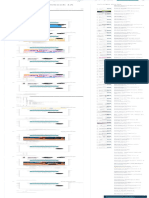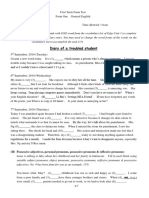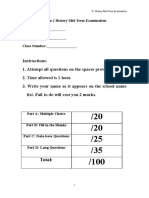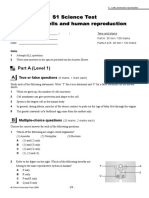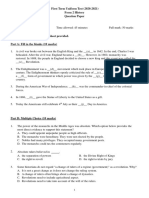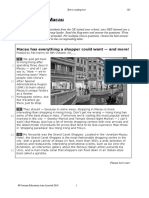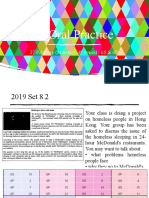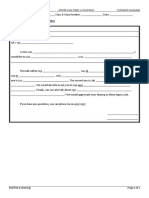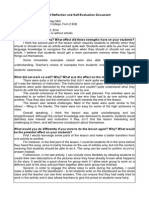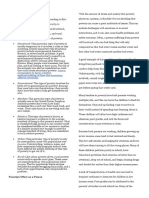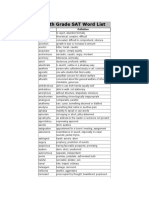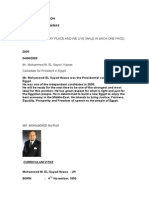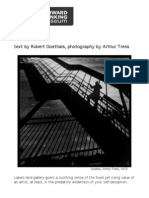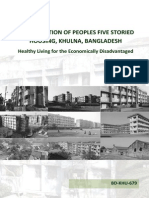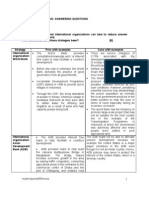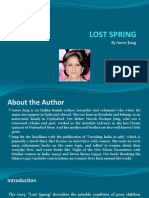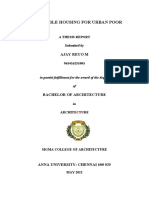Twghs Wong Fut Nam College Second Term Standardized Test 2014-2015 Form 1 Geography
Twghs Wong Fut Nam College Second Term Standardized Test 2014-2015 Form 1 Geography
Uploaded by
Yan Hao NamCopyright:
Available Formats
Twghs Wong Fut Nam College Second Term Standardized Test 2014-2015 Form 1 Geography
Twghs Wong Fut Nam College Second Term Standardized Test 2014-2015 Form 1 Geography
Uploaded by
Yan Hao NamOriginal Description:
Original Title
Copyright
Available Formats
Share this document
Did you find this document useful?
Is this content inappropriate?
Copyright:
Available Formats
Twghs Wong Fut Nam College Second Term Standardized Test 2014-2015 Form 1 Geography
Twghs Wong Fut Nam College Second Term Standardized Test 2014-2015 Form 1 Geography
Uploaded by
Yan Hao NamCopyright:
Available Formats
2014-15/F.1/2nd Term Standardized Test/Geography/p.
TWGHs Wong Fut Nam College
Second Term Standardized Test
2014-2015
Form 1 Geography
Setter: Mr. Yan Haonam Date: 23rd March, 2015
Total marks: 51 Time: 15:00 15:30
Total no. of pages: 4 Time allowed: 30 minutes
Instructions:
1. Answer ALL questions.
2. Put all the answers on the answer sheet provided.
3. TWO marks will be given for well-presented answers and in complete
sentences.
Go on to the next page!
2014-15/F.1/2nd Term Standardized Test/Geography/p.2
1. Photograph 1 shows Place A in Hong Kong.
Photograph 1
!
(a) What is the type of urban land use shown in Photograph 1? (1 mark)
(b) Describe THREE characteristics of the buildings found in this type of urban land (6 marks)
use.
(c) (i) Where can you find this type of land use in Hong Kong? Name THREE (3 marks)
districts.
(ii) Why is such a land use type found in these districts? Give ONE reason. (2 marks)
(d) Mr. Chan is a waiter working in one of the restaurants (Caf de Carol) in the photo. (4 marks)
He is planning to move to the place shown in the photo. Would you recommend
him to move to this place? Give TWO reasons to explain your answer.
Go on to the next page!
2014-15/F.1/2nd Term Standardized Test/Geography/p.3
2. Figure 2a (printed on page 5 of the answer sheet) shows the map of Central, the Central Business
District (CBD) of Hong Kong. Photographs 2b, 2c and 2d show Places X, Y and Z respectively.
Photograph 2b Photograph 2c Photograph 2d
(a) Refer to Figure 2a.
(i) Write down the grid reference of Places X, Y and Z respectively. (6 marks)
(ii) Mark the following facilities on the map provided on your page 5 of your
answer sheet using conventional signs.
(1) A fire station at 852211 (2 marks)
(2) A church at 824214 (2 marks)
(b) Refer to Photographs 2b, 2c and 2d.
(i) What are the types of urban land use shown in the photos? (3 marks)
(ii) Give THREE characteristics of the buildings found in the CBD. (6 marks)
(iii) Give TWO reasons to explain why many business people would like to set up (4 marks)
their firms in the CBD.
(iv) Suppose you are planning to set up a $10-shop (a shop selling most things at (6 marks)
$10 each). Would you choose to set up your shop in Central or Tin Shui Wai?
Give THREE reasons to support your answer.
(v) Why is there no industrial land use in Central District? Give TWO reasons. (4 marks)
- END OF TEST -
Go on to the next page!
2014-15/F.1/2nd Term Standardized Test/Geography/p.4
TWGHs Wong Fut Nam College Parents signature:
F.1 Geography (2014-2015)
Second Term Standardized Test Answer Sheet
Name: __________________________ ( ) Class: F.1 _______ Marks: ______/51
Question 1
(a) (1 marks)
(b)
(6 marks)
(c) (i)
(3 marks)
(ii)
(2 marks)
(d)
(4 marks)
Question 2
(a) (i) X: (2 marks) Y: (2 marks)
Z: (2 marks)
(ii) Refer to the map on the next page for answering this question. (4 marks)
(b) (i)
(3 marks)
(ii)
(6 marks)
Go on to the next page!
2014-15/F.1/2nd Term Standardized Test/Geography/p.5
(iii)
(4 marks)
(iv)
(6 marks)
(v)
(4 marks)
Map for Question 2(a)(ii)
23
22
. Y
. Z
21
. X
83 84 85
Effective Communication
- END OF ANSWER SHEET-
Go on to the next page!
2014-15/F.1/2nd Term Standardized Test/Geography/p.6
TWGHs Wong Fut Nam College
F.1 Geography (2014-2015)
First Term Test Suggested Answer
Question 1
(a) Mixed land use d (3 marks)
(b) - There are different types of land use in one building. f
- The ground floor and the lower floors are shops / offices. D
- The upper floors are residential units. D
- The buildings are close together / crowded. D (any 3, 6 marks)
(c) (i) Yau Ma Tei, Wan Chai, Mong Kok, Tsuen Wan, Cheung Sha Wan, etc. f(any 3, 3 marks)
(ii) - Lack of urban planning / land use planning in the past D (2 marks)
(d) For yes:
- It is convenient for him to go to work.
- The rent there is lower.
- The traffic is convenient // It has a good transport network.
For no:
- The living environment is poor. // There may be noise and air pollution.
- There may be traffic congestion.
- There is a high degree of fire. // It is very dangerous (award 1 mark only if not
mentioning fire)
(Any 2 reasons, 4 marks; Any contradictions with the preference => 0 marks for that point)
Question 2
(a) (i) X: (2 marks) Y: (2 marks)
Z: (2 marks)
(ii) Refer to the map on the next page for answering this question.
(b) (i) Photograph 2b: Commercial land use (1 mark)
Photograph 2c: Transport land use (1 mark)
Photograph 2d: Recreational land use (1 mark)
(ii) - The buildings are tall. D
- They are nicely designed / modern. D
- The rent is high. OR The land value is high. D
- The building density is high. D
- They are mostly for commercial use. D
OR they are mostly shops / offices / hotels / banks, etc. D (any 3, 6 marks)
Go on to the next page!
2014-15/F.1/2nd Term Standardized Test/Geography/p.7
(iii) - The transport is convenient. Customers and business partners can reach their officesD
easily. D
- It is prestigious to have offices in the CBD. OR It is a symbol of status. D
- They can afford to pay the high rent. D
- Many large companies are concentrated in the CBD. It is easier for them to do business D
with each other. D (any 2, 4 marks)
(iv) - Tin Shui Wai (Must get this correct to get any marks). D
- The rent is low. D
- There are many public housing estates / Population density is high. D
- There are large amount of (target) customers. D
- Most of the people living there have low income, they can afford cheaper goods. D
- The goods are light and can be easily transported to Tin Shui Wai D
by lorries. D (any 3, 6 marks)
(v) - The rent in CBD is very high. D
- Only commercial firms can afford the high rent. D
- They have earn more money per unit area. OR They have a high money-making ability.D
- Factory owners cannot afford the rent. D (any 2, 4 marks)
Map for Question 2(a)(ii)
23
22
. Y
. Z
. X
21
83 84 85
effective communication: max. 2 marks
Go on to the next page!
You might also like
- CLUP RodriguezDocument105 pagesCLUP RodriguezNicole Verosil100% (3)
- Unit 1 Introducing Science: Section ExerciseDocument9 pagesUnit 1 Introducing Science: Section Exerciseyurisakaiyoa100% (2)
- F1 Exam 1 Sample Paper PDFDocument6 pagesF1 Exam 1 Sample Paper PDFjuliec100% (2)
- Geog 20-21 S1 CT1 PDFDocument10 pagesGeog 20-21 S1 CT1 PDF1F-17 Li Jasmine Tin Yan100% (2)
- Reply Speeches What Are They?Document2 pagesReply Speeches What Are They?Yan Hao Nam89% (9)
- S3 Geography Mock PaperDocument12 pagesS3 Geography Mock Paperharis Rehman100% (2)
- 2223-IS-S2-T1-Exam - Question PaperDocument12 pages2223-IS-S2-T1-Exam - Question PaperviclaukkNo ratings yet
- CHP 1 Suggested AnswerDocument10 pagesCHP 1 Suggested AnswerRachel Wong74% (31)
- S3 Map Exercise 1Document3 pagesS3 Map Exercise 1Olivia Lin100% (1)
- Using Urban Space Wisely MCDocument10 pagesUsing Urban Space Wisely MCKevin Wsy100% (2)
- Test AnswersDocument19 pagesTest AnswersasjdasjdNo ratings yet
- Urban Worksheet - StudentDocument29 pagesUrban Worksheet - StudentChris Wong100% (1)
- 1415 - S1 - Using Urban Space Wisely - Unit 1.1Document5 pages1415 - S1 - Using Urban Space Wisely - Unit 1.1DickyNo ratings yet
- Jsci Ans wb1 eDocument12 pagesJsci Ans wb1 e5xgx3456100% (2)
- St. Pauls Secondary School 2020 2021 F3 Phy 1st Term TestDocument10 pagesSt. Pauls Secondary School 2020 2021 F3 Phy 1st Term Testgamecenreya100% (2)
- F4 Final Eng P1 Q&ADocument12 pagesF4 Final Eng P1 Q&A吳心No ratings yet
- Po Kok Secondary School: S.1 Integrated ScienceDocument76 pagesPo Kok Secondary School: S.1 Integrated ScienceKevin WsyNo ratings yet
- F1 2021-2022 L&S Final Term ExamDocument6 pagesF1 2021-2022 L&S Final Term ExamchloeNo ratings yet
- Scicent AB TE U11 eDocument26 pagesScicent AB TE U11 eYuenHei KwokNo ratings yet
- S3 - Geo - 2nd Term Exam Revision Industry 2Document8 pagesS3 - Geo - 2nd Term Exam Revision Industry 2Billy Lau100% (1)
- Queen's College Half-Yearly Examination 2016-2017 English Language I General EnglishDocument52 pagesQueen's College Half-Yearly Examination 2016-2017 English Language I General EnglishTimmy SzeNo ratings yet
- Measuring New Media LiteraciesDocument13 pagesMeasuring New Media LiteraciesYan Hao NamNo ratings yet
- MB 070217Document58 pagesMB 070217coed_emcNo ratings yet
- Kwun Tong Government SecondaryDocument15 pagesKwun Tong Government SecondaryRebe100% (2)
- 1415 - S1 - Using Urban Space Wisely - Unit 1.4Document8 pages1415 - S1 - Using Urban Space Wisely - Unit 1.4DickyNo ratings yet
- Scicent SQ U1 3-4 SetB Final R eDocument5 pagesScicent SQ U1 3-4 SetB Final R eApple LouNo ratings yet
- 20-21 IS First Term Test - QDocument8 pages20-21 IS First Term Test - QamyNo ratings yet
- S1 GE PaperDocument8 pagesS1 GE PapermelanieplchanNo ratings yet
- Ho Lap College Second Revision Test (2018-19) F.1 Integrated Science Time Allowed: 20 MinutesDocument5 pagesHo Lap College Second Revision Test (2018-19) F.1 Integrated Science Time Allowed: 20 Minutes冷燄No ratings yet
- S1IS - 2018-2019 - Aristo - Science For The New Century - 1ADocument55 pagesS1IS - 2018-2019 - Aristo - Science For The New Century - 1Anm229sdxycNo ratings yet
- Unit TestDocument11 pagesUnit TestCHUN YIN LEUNGNo ratings yet
- 2 The Trouble With Water - TeacherDocument23 pages2 The Trouble With Water - TeacherLouisa Lau100% (1)
- 2020-21-S2 GeographyDocument13 pages2020-21-S2 GeographywuhoyinNo ratings yet
- S1 Science Term OneDocument11 pagesS1 Science Term Onec21fw.csyNo ratings yet
- Sing Yin Secondary School First Term Examination, 2012-2013 HistoryDocument4 pagesSing Yin Secondary School First Term Examination, 2012-2013 HistoryLorraine Tsoi50% (2)
- Scicent SQ U3 1-2 SetA Final eDocument6 pagesScicent SQ U3 1-2 SetA Final esteve LNo ratings yet
- Scicent SQ U1 1-2 SetA Final R eDocument4 pagesScicent SQ U1 1-2 SetA Final R eApple LouNo ratings yet
- Aristo Science Workbook 1A (Answer) PDF Solubility EvaporationDocument1 pageAristo Science Workbook 1A (Answer) PDF Solubility Evaporationntlroblox870% (1)
- ST Stephen Girl College F1-Maths-16-17-myDocument9 pagesST Stephen Girl College F1-Maths-16-17-mybrian123456720% (1)
- Sectiona: Multiplechoice (2marks@.24%) : Answer All QuestionsDocument6 pagesSectiona: Multiplechoice (2marks@.24%) : Answer All QuestionsYuki Li100% (1)
- S1-English-First Test Wih Ans 2020Document12 pagesS1-English-First Test Wih Ans 2020melanieplchan100% (1)
- Form 2 History Mid Term ExaminationDocument12 pagesForm 2 History Mid Term ExaminationTse Ling100% (1)
- F1 Science Specimen - Question 1Document6 pagesF1 Science Specimen - Question 1ellessewongNo ratings yet
- S1 Is First Term ExamDocument8 pagesS1 Is First Term ExamNicole Yau100% (1)
- S1 Geography Urban Notes 2021 Student Version 1.6 1 PDFDocument2 pagesS1 Geography Urban Notes 2021 Student Version 1.6 1 PDFjuliec100% (3)
- F2 Unit 7 (Challenging)Document15 pagesF2 Unit 7 (Challenging)alanso98No ratings yet
- Scicent SQ U8 3-4 SetB Final eDocument7 pagesScicent SQ U8 3-4 SetB Final eApple Lou100% (1)
- WS Part4.1 TE eDocument3 pagesWS Part4.1 TE emramesng.spamNo ratings yet
- f1 Geog NotesDocument12 pagesf1 Geog NotesTse LingNo ratings yet
- s1 Topic 11 Water Purification & The Water CycleDocument20 pagess1 Topic 11 Water Purification & The Water CycleYuki LiNo ratings yet
- Term Exam Eng PDFDocument88 pagesTerm Exam Eng PDFKin Wai HongNo ratings yet
- F2 English August TestDocument11 pagesF2 English August TestQing YiNo ratings yet
- F2ISExam1 (01-02) (修復)Document38 pagesF2ISExam1 (01-02) (修復)羅天佑No ratings yet
- 03 Cells and Human ReproductionDocument10 pages03 Cells and Human ReproductionYan WongNo ratings yet
- Scicent SQ U2 1 SetA Final eDocument5 pagesScicent SQ U2 1 SetA Final esteve LNo ratings yet
- 2020-21-S2 HistoryDocument12 pages2020-21-S2 Historywuhoyin100% (1)
- 1112 Final Eng.1 s4 Question-Answer BookDocument13 pages1112 Final Eng.1 s4 Question-Answer BookBROFISTSIDNo ratings yet
- 1718 2nd Ut f3 Geog QPDocument8 pages1718 2nd Ut f3 Geog QP惜靈靜雅No ratings yet
- S1 Science Yearly Exam 2020 2021 v3 PDFDocument8 pagesS1 Science Yearly Exam 2020 2021 v3 PDFjvmwdbp2jcNo ratings yet
- Edge JS2 ERT Shopping in MacauDocument10 pagesEdge JS2 ERT Shopping in MacauFung AlexNo ratings yet
- English Language Paper 2 Question-Answer Book: Kenneth LauDocument14 pagesEnglish Language Paper 2 Question-Answer Book: Kenneth LauMelodyLoNo ratings yet
- WS Part4 SB eDocument41 pagesWS Part4 SB emramesng.spam100% (1)
- 2009 Longman Book 1A Mock PaperDocument43 pages2009 Longman Book 1A Mock PaperVictor NgNo ratings yet
- To Download Ntse Stage II Paper 2014Document39 pagesTo Download Ntse Stage II Paper 2014devesh pal0% (1)
- 20232024_Geog_S1_Test 1_QPDocument4 pages20232024_Geog_S1_Test 1_QPRicky LINo ratings yet
- S6 Speaking Practice (Feb)Document15 pagesS6 Speaking Practice (Feb)Yan Hao NamNo ratings yet
- GHS 2021 Paper 1Document10 pagesGHS 2021 Paper 1Yan Hao NamNo ratings yet
- 1920 DGS Eng Mock Paper 2B Q2-1Document5 pages1920 DGS Eng Mock Paper 2B Q2-1Yan Hao NamNo ratings yet
- Process Writing FlowchartDocument1 pageProcess Writing FlowchartYan Hao NamNo ratings yet
- Monthly Writing Practice (Feb)Document3 pagesMonthly Writing Practice (Feb)Yan Hao NamNo ratings yet
- t114000 - 230511 080314 43cDocument1 paget114000 - 230511 080314 43cYan Hao NamNo ratings yet
- Tenses With Perfect AspectsDocument2 pagesTenses With Perfect AspectsYan Hao NamNo ratings yet
- 2015 Part B Task 2 - Email To An Author: C&MA Sun Kei Secondary School HKCEE 2005 Paper 3 Corrections S3 English LanguageDocument2 pages2015 Part B Task 2 - Email To An Author: C&MA Sun Kei Secondary School HKCEE 2005 Paper 3 Corrections S3 English LanguageYan Hao NamNo ratings yet
- Expressions For Argumentative WritingDocument1 pageExpressions For Argumentative WritingYan Hao NamNo ratings yet
- Part 1. Vocabulary (Items 101 - 150) : C&MA Sun Kei Secondary School Vocab 1000 Dictation 4 S4 English Language (YH)Document4 pagesPart 1. Vocabulary (Items 101 - 150) : C&MA Sun Kei Secondary School Vocab 1000 Dictation 4 S4 English Language (YH)Yan Hao NamNo ratings yet
- Hong Kong Schools Speech Festival 2015 - Teacher Training: The English-Speaking Union HKDocument1 pageHong Kong Schools Speech Festival 2015 - Teacher Training: The English-Speaking Union HKYan Hao NamNo ratings yet
- 5 FB e 1stDocument5 pages5 FB e 1stYan Hao NamNo ratings yet
- Reflection DaisyDocument2 pagesReflection DaisyYan Hao NamNo ratings yet
- People To Form and Raise Families: We Want To GetDocument5 pagesPeople To Form and Raise Families: We Want To GetYan Hao NamNo ratings yet
- Unit 1 Unit Tasks (P. 11) Audio FromDocument1 pageUnit 1 Unit Tasks (P. 11) Audio FromYan Hao NamNo ratings yet
- Child Language Summary NoteDocument9 pagesChild Language Summary NoteYan Hao NamNo ratings yet
- Oceans - : Evaporation From SeaDocument1 pageOceans - : Evaporation From SeaYan Hao NamNo ratings yet
- Design Criteria For Pedagogic Language RulesDocument12 pagesDesign Criteria For Pedagogic Language RulesYan Hao NamNo ratings yet
- Types of Poverty: Learn Economics To Have A Better Understanding of How The Economy Affects EveryoneDocument4 pagesTypes of Poverty: Learn Economics To Have A Better Understanding of How The Economy Affects Everyoneluckii8star100% (1)
- 10th Grade SAT Word ListDocument10 pages10th Grade SAT Word ListMicaela Davis100% (1)
- 25hawas FoundationDocument18 pages25hawas FoundationAhmed Emad AhmedNo ratings yet
- Agriculture Development Strategy 2013-NepalDocument274 pagesAgriculture Development Strategy 2013-NepalRamindra Suwal100% (1)
- Women Contribution in Economic DevelopmentDocument17 pagesWomen Contribution in Economic DevelopmentSachin Jain SjNo ratings yet
- Environmental Justice: Implications For THE BALTIMORE RED LINE Transit Project by Tracee Strum-GilliamDocument19 pagesEnvironmental Justice: Implications For THE BALTIMORE RED LINE Transit Project by Tracee Strum-GilliamNational Environmental Justice Conference and Training ProgramNo ratings yet
- No LabelDocument8 pagesNo Labeldaddypanama100% (1)
- Industrial+Conflict 2Document10 pagesIndustrial+Conflict 2angelsaraswatNo ratings yet
- NAPA EthiopiaDocument49 pagesNAPA EthiopiaambuyiyeNo ratings yet
- IBM Course Outline - T5 2022Document8 pagesIBM Course Outline - T5 2022AyushiNo ratings yet
- Political Economic Interpretation of The World Is An AppleDocument3 pagesPolitical Economic Interpretation of The World Is An ApplePaul Mark CruzNo ratings yet
- Genesis and Growth of NGOs PDFDocument8 pagesGenesis and Growth of NGOs PDFSopnil Abdullah0% (1)
- Chapter 4-Poverty and InequalityDocument27 pagesChapter 4-Poverty and InequalityAnthony BandaNo ratings yet
- Rury and Mirel, Political Economy of Urban EducationDocument63 pagesRury and Mirel, Political Economy of Urban EducationJeremyCohanNo ratings yet
- Kajiado-CIDP 2013-2017 PDFDocument234 pagesKajiado-CIDP 2013-2017 PDFFREDRICK WAREGA100% (1)
- Affordable Land and Housing in AfricaDocument101 pagesAffordable Land and Housing in AfricaUnited Nations Human Settlements Programme (UN-HABITAT)100% (5)
- Report KhulnaDocument52 pagesReport KhulnaRaka SiddiquaNo ratings yet
- Food SecurityDocument3 pagesFood SecurityMANZANA MARY JOY A.No ratings yet
- Geography Elective NotesDocument4 pagesGeography Elective NotesNeera Vijay100% (3)
- 9.1. ALSTOTT, Anne L. Private Tragedies - Family Law As Social Insurance P. 3-11Document9 pages9.1. ALSTOTT, Anne L. Private Tragedies - Family Law As Social Insurance P. 3-11Antonio Wajnman LimaNo ratings yet
- 25 Siliguri Draft ReportDocument72 pages25 Siliguri Draft Reportrahulchow2No ratings yet
- The Philippines A Century HenceDocument2 pagesThe Philippines A Century HenceRuby VentajarNo ratings yet
- TA 4665 PAK Power Transmission Enhancement Project - PakistanDocument45 pagesTA 4665 PAK Power Transmission Enhancement Project - PakistanJaved RashidNo ratings yet
- LA County - CommunityofContrasts - 2013Document36 pagesLA County - CommunityofContrasts - 2013Southern California Public RadioNo ratings yet
- Lost Spring: by Anees JungDocument13 pagesLost Spring: by Anees JungVIRUNo ratings yet
- A Comparative PESTEL Analysis of Canada PDFDocument47 pagesA Comparative PESTEL Analysis of Canada PDFsparshNo ratings yet
- Affordable Housing For Urban Poor: Ajay Reyo MDocument8 pagesAffordable Housing For Urban Poor: Ajay Reyo MObito UchihaNo ratings yet



